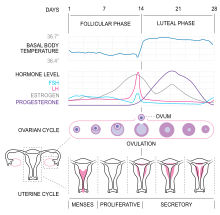Follicular phase
This article needs more primary sources. (December 2017) |  |
| Follicular phase | |
|---|---|
 Figure 1. Menstrual cycle illustrating hormone levels, follicle development and uterine cycle | |
| Biological system | Urogenital system(reproductive) |
The follicular phase, also known as the preovulatory phase or proliferative phase,
Hormonal events
Protein secretion
Due to the increase of FSH, the protein
Follicle recruitment

Follicle-stimulating hormone (FSH) is secreted by the anterior pituitary gland (Figure 2). FSH secretion begins to rise in the last few days of the previous menstrual cycle,[3] and is the highest and most important during the first week of the follicular phase[4] (Figure 1). The rise in FSH levels recruits five to seven tertiary-stage ovarian follicles (this stage follicle is also known as a Graafian follicle or antral follicle) for entry into the menstrual cycle. These follicles, that have been growing for the better part of a year in a process known as folliculogenesis, compete with each other for dominance.[5]
FSH induces the proliferation of
Throughout the entire follicular phase, rising estrogen levels in the blood stimulates growth of the endometrium and myometrium of the uterus.[6] It also causes endometrial cells to produce receptors for progesterone,[6] which helps prime the endometrium to respond to rising levels of progesterone during the late proliferative phase and throughout the luteal phase.
Estrogen surge
Two or three days before LH levels begin to increase,[7] usually by day seven of the cycle,[8] one (or occasionally two) of the recruited follicles has emerged as dominant. Many endocrinologists believe that the estrogen secretion of the dominant follicle has increased to a level that GnRH production is suppressed, which lowers the levels of LH and FSH. This slowdown in LH and FSH production leads to the atresia (death) of most of the recruited follicles, though the dominant follicle continues to mature. Estrogen levels will continue to increase for several days (on average, six days, but this varies widely).[7]
These high estrogen levels initiate the formation of a new layer of
LH surge and ovulation
Estrogen levels are highest right before the
Follicular waves
Follicular waves are best described as the phase when follicles have matured sufficiently and rupture, leading to ovulation. Recent findings into the menstrual cycle in mammals has discovered that 2 or more follicles can develop but only one of the follicles fully matures to release the egg.[14][15] This follicular wave involves multiple surges in the levels of FSH to initiate follicular development. A study has found that 68% of women tended to display two follicular wave developments before ovulation while the remaining had three waves.[16]
References
- ^ license.
- ^ "Primate | Definition, Biology, & Facts | Britannica". 3 January 2024.
- PMID 25905282.
- ^ ISBN 0-13-102015-3.
- ^ McGee, E.A., & Hsueh, A.J. (2000). Initial and cyclic recruitment of ovarian follicles. Endocrine Reviews, 200-214, 21(2). doi: 10.1210/edrv.21.2.0394
- ^ ISBN 0-07-111677-X.)
{{cite book}}: CS1 maint: multiple names: authors list (link - ^ ISBN 0-06-093764-5.
- ISBN 0-323-01402-X.
- ^ Weschler (2002), p.57
- ^ Weschler (2002), illustrations p.59 and p.3 of color insert
- ^ Weschler (2002), pp.54,306,310
- ^ Weschler (2002), p.65
- S2CID 40401379.
- PMID 10735037.
- PMID 22118087.
- PMID 12748128.
